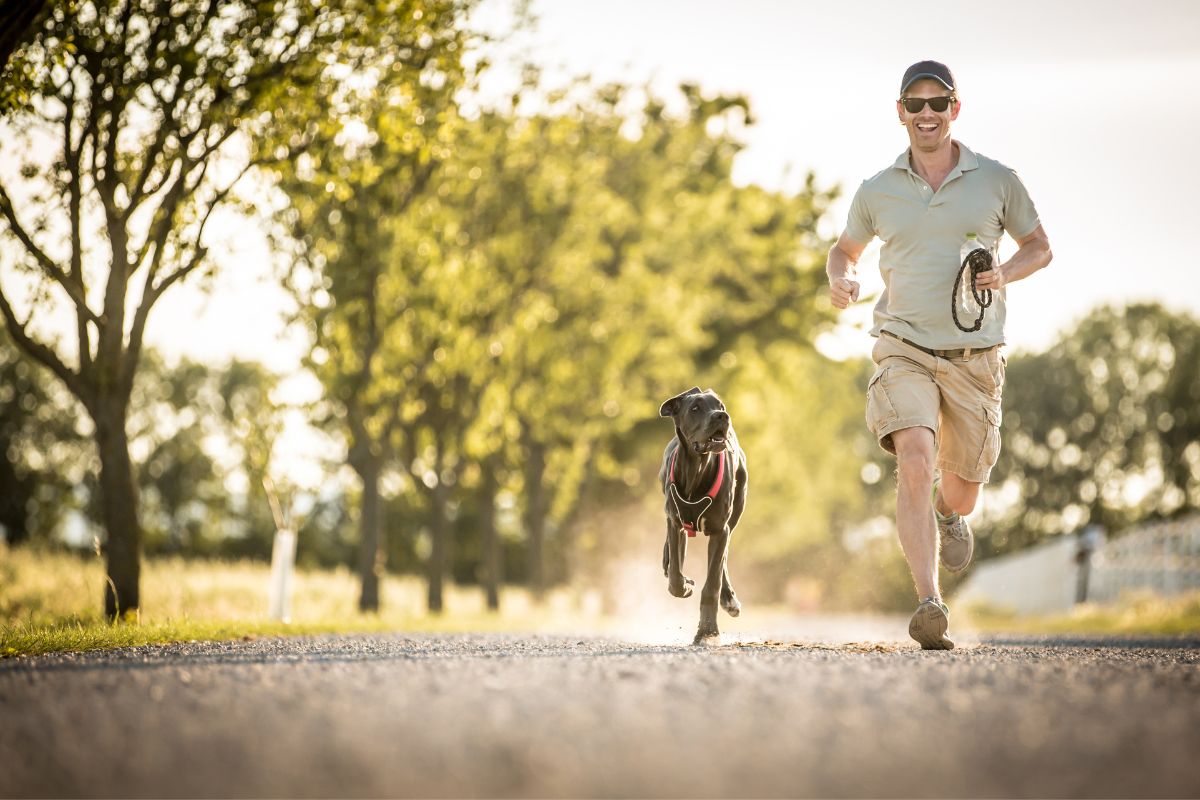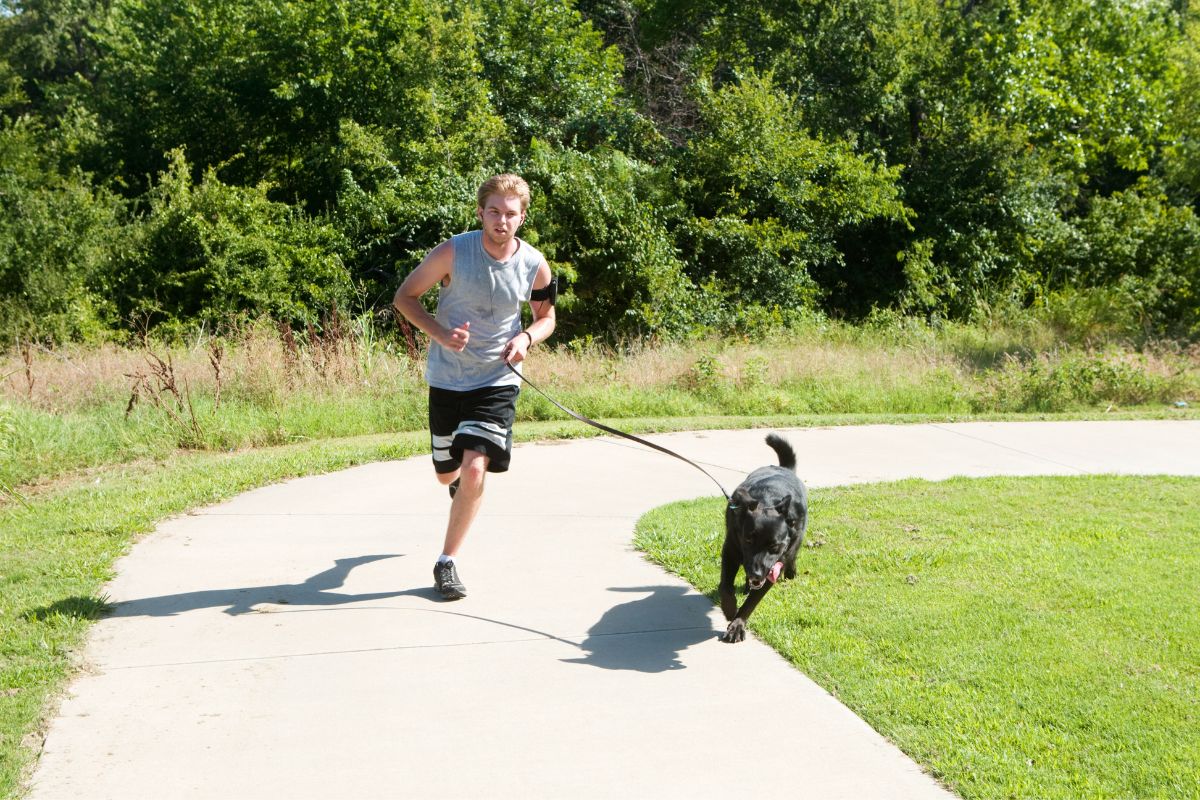Running with your dog is a great way to exercise both of you and will also help build the bond between you and your four-legged companion.

Some active breeds of dog will absolutely love to come on your runs with you and will be a lot happier and healthier because of it, after all – a tired dog is a happy dog.
However, there are some things that you will have to think of before you start running with your dog, as health issues such as joint problems or heart problems can restrict how far, fast or even the overall possibility of running together.
Some dogs will also have a harder time than others to fully understand what you want from them as you run, as some will think of it as a game and will try to wrestle you whilst others will simply follow their nose and disappear into the bushes.
Keep reading to find out all of the top tips to running with your dog.
Knowing Whether You Can Run With Your Dog
Puppies of all breeds should not be taken on regular, routine, or extended walks. In general, you should not start running with a puppy before six months of age; any earlier, and you risk harming its growing joints and muscles.
Many high-energy dogs, such as boxers and pit bulls, make good running companions, but they do not endure long runs well.
American Staffordshire terriers, bull terriers, and Staffordshire bull terriers, have a lot of activity but not a lot of stamina or heat tolerance; they are only ideal for short runs in colder weather.
Running long distances with brachycephalic dogs such as bulldogs, pugs, or other heat-sensitive breeds is not recommended. They may experience tiredness, overheating, and breathing difficulties.
Although there are exceptions, gigantic dogs and other canines prone to orthopedic disorders might suffer from joint discomfort and injury if they run great distances repeatedly.
Small, short-legged dogs, such as corgis or dachshunds, may struggle to keep up and fatigue rapidly on lengthy outings.
Mixed breeds from your local animal shelter can also make excellent jogging companions.
If they suffer from a form of anxiety like some shelter dogs do, running can actually help with some of these issues as it tires them out and releases that pent up energy.
When evaluating if running is good for your dog, consider their personality – even a healthy dog may be hesitant to run alongside you.
Look at your dog’s body language when you’re out for walks or exercising off lead to see if he or she is likely to love running.
Running may not be ideal for your dog if they appear worried as you walk away, or if they are unwilling to step up the pace when training.
Dog Health Problems And Running
Before making any modifications to your dog’s exercise routine, regardless of their age, you should contact your veterinarian. Any dog can have a medical issue that makes running risky.
Heart, lung, muscular, bone, and joint problems can all put your dog at risk of additional harm if he engages in excessive physical exercise.
Some breeds are predisposed genetically to acquiring these diseases. Hip dysplasia, for example, is common in German Shepherds. Your veterinarian should be extra vigilant for these problems.

How To Start Running With Your Dog
Introduce any dog to a jogging program gradually.
Begin at a comfortable pace where you can effectively converse with your dog. (You don’t want to be winded when attempting to slow down an enthusiastic dog on the road.) And begin with two to three miles throughout your three to four weekly runs.
After a week or so of jogging at that leisurely pace, consider adding 0.5 mile or 10 minutes to your initial two or three mile weekly outings.
If your dog tolerates the 0.5 mile increase with ease, consider increasing the speed or adding an extra run on weekends.
After a month of preparation and confirming that your dog can comfortably manage the base mileage, consider a four to five mile/day regimen.
Remember that most dog trainers highly advise at least one, if not two, days of rest for both you and your dog.
Training Your Dog To Run Nicely Beside You
Before you start teaching your dog to run beside you, he or she should master loose-leash walking. When strolling, a canine friend that tugs on the leash is inconvenient, but dangerous at higher speeds.
Keep in mind that the surroundings is full with incentives, such as squirrels and unusual odors.
If you are wanting your dog to keep nearby, with the leash in a J shape, you must be equally rewarding. Use food, toys, and praise to encourage your dog to keep the leash loose.
Now that your dog is gently strolling with you, it’s time to pick up the pace. When you’re out on a walk, having a cue, like “let’s go,” that signals your dog it’s time to go on and start walking is useful.
To instruct your dog to step up the pace, use a new cue, such as “get running” or “move it.” The more information you can provide your dog about what you expect, the better they will respond.
It’s time to get your dog in shape now that they know to stay by your side and match your speed. Your dog, like people, must gradually acquire strength and endurance.
Begin by adding short bursts of running into your walks.
Then, on each consecutive stroll, steadily increase the time you spend jogging and reduce the amount of time you spend walking. Your dog will be accustomed to running long distances within a few weeks.
Summary
As mentioned earlier, going for jogs with your dog can be a really rewarding experience for both of you.
As long as your dog is healthy and happy when it comes to these jogs and you have built up a training routine to ease them into it, then there is no reason why they should miss out on the fun.
- Can Dogs Run Faster Than Humans? (Running With Your Furry Friend) - October 4, 2022
- 10 Doggie Fun Runs You Will Love [Ultimate Guide] - October 4, 2022
- What Are Division Results In Running? - October 4, 2022








